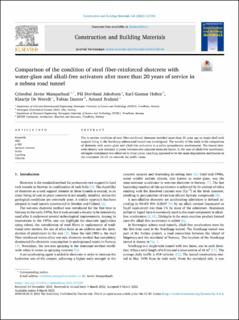| dc.contributor.author | Manquehual Mery, Cristobal Javier | |
| dc.contributor.author | Jakobsen, Pål Drevland | |
| dc.contributor.author | Holter, Karl Gunnar | |
| dc.contributor.author | De Weerdt, Klaartje | |
| dc.contributor.author | Danner, Tobias Alexander | |
| dc.contributor.author | Bruland, Amund | |
| dc.date.accessioned | 2022-03-18T06:51:28Z | |
| dc.date.available | 2022-03-18T06:51:28Z | |
| dc.date.created | 2022-03-10T09:23:46Z | |
| dc.date.issued | 2022 | |
| dc.identifier.issn | 0950-0618 | |
| dc.identifier.uri | https://hdl.handle.net/11250/2986006 | |
| dc.description.abstract | The in-service condition of steel fiber-reinforced shotcrete installed more than 20 years ago as single-shell rock support lining in the Nordkapp subsea road tunnel was investigated. The novelty of this study is the comparison of shotcrete with water–glass and alkali-free activators in a saline groundwater environment. The lowest shotcrete density was obtained at joints between two adjacent shotcrete layers. In the case of alkali-free accelerator, ettringite enrichment was observed in these joints. Leaching appeared to be the main degradation mechanism in the outermost 10–15 cm towards the traffic room. | |
| dc.language.iso | eng | |
| dc.publisher | Elsevier | |
| dc.rights | CC BY 4.0 | |
| dc.rights.uri | http://creativecommons.org/licenses/by/4.0/ | |
| dc.subject | XRD | |
| dc.subject | μ-XRF | |
| dc.subject | Sprayed concrete | |
| dc.subject | Sulfur | |
| dc.subject | Leaching | |
| dc.subject | Chloride | |
| dc.title | Comparison of the condition of steel fiber-reinforced shotcrete with water-glass and alkali-free activators after more than 20 years of service in a subsea road tunnel | |
| dc.type | Peer reviewed | |
| dc.type | Journal article | |
| dc.description.version | publishedVersion | |
| dc.rights.holder | © 2022 The Authors | |
| dc.subject.nsi | VDP::Teknologi: 500 | |
| dc.source.volume | 328 | |
| dc.source.journal | Construction and Building Materials | |
| dc.identifier.doi | 10.1016/j.conbuildmat.2022.127090 | |
| dc.identifier.cristin | 2008696 | |
| dc.source.articlenumber | 127090 | |
| cristin.ispublished | true | |
| cristin.fulltext | original | |
| cristin.qualitycode | 2 | |

